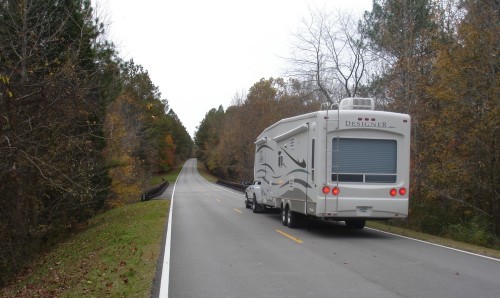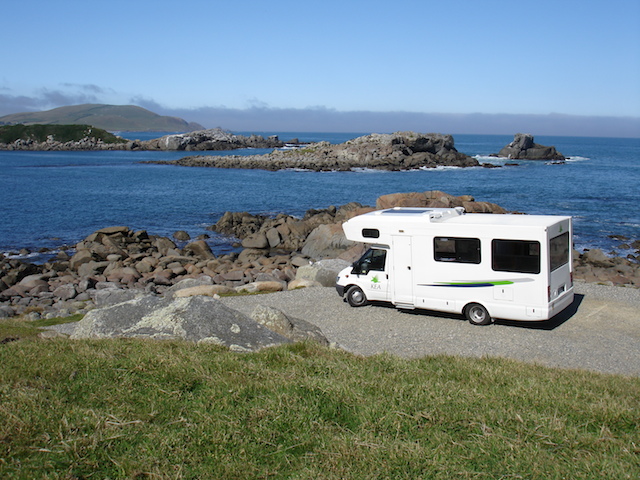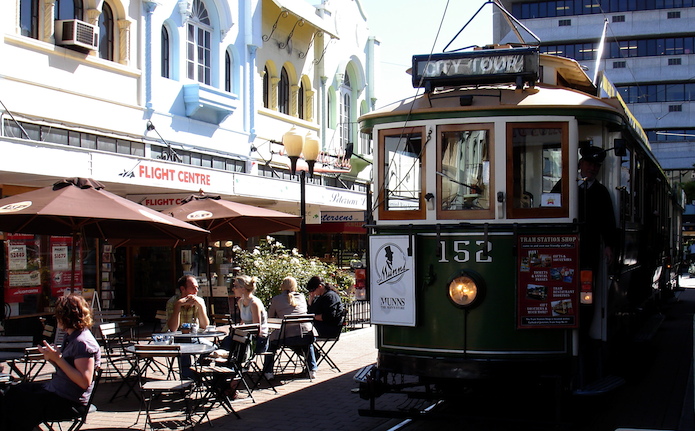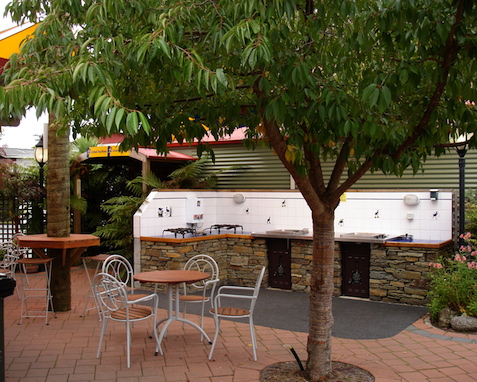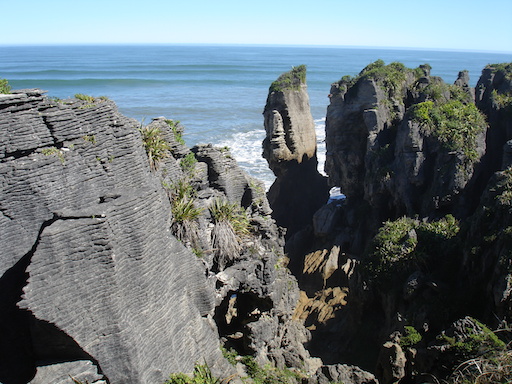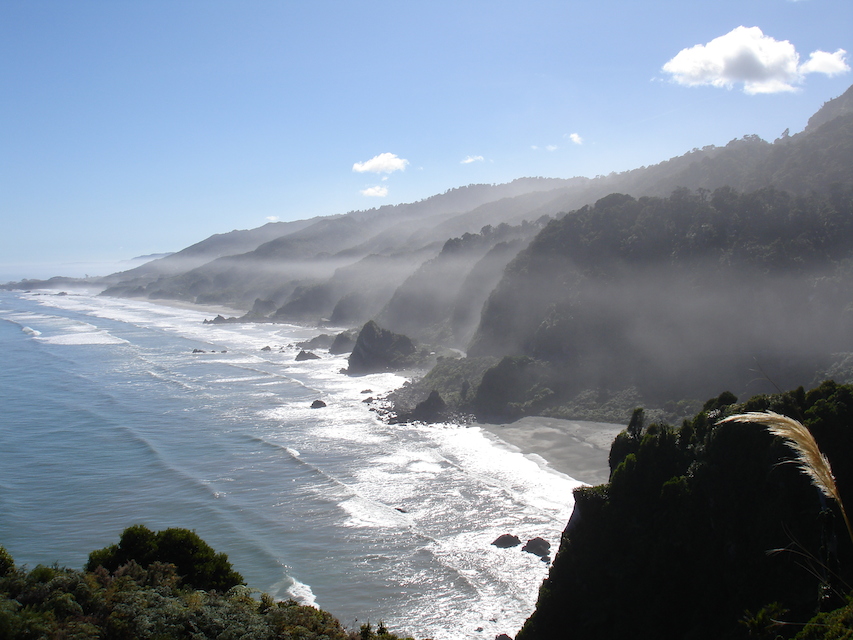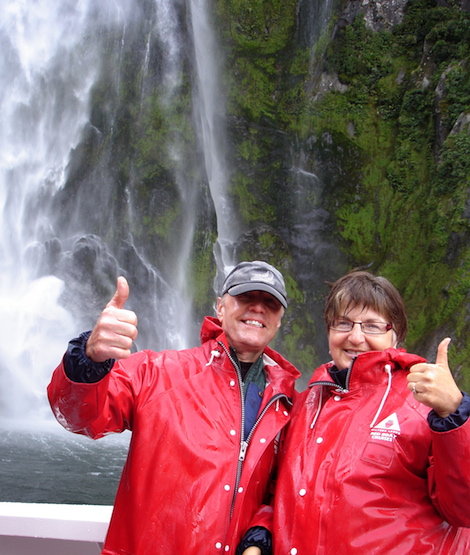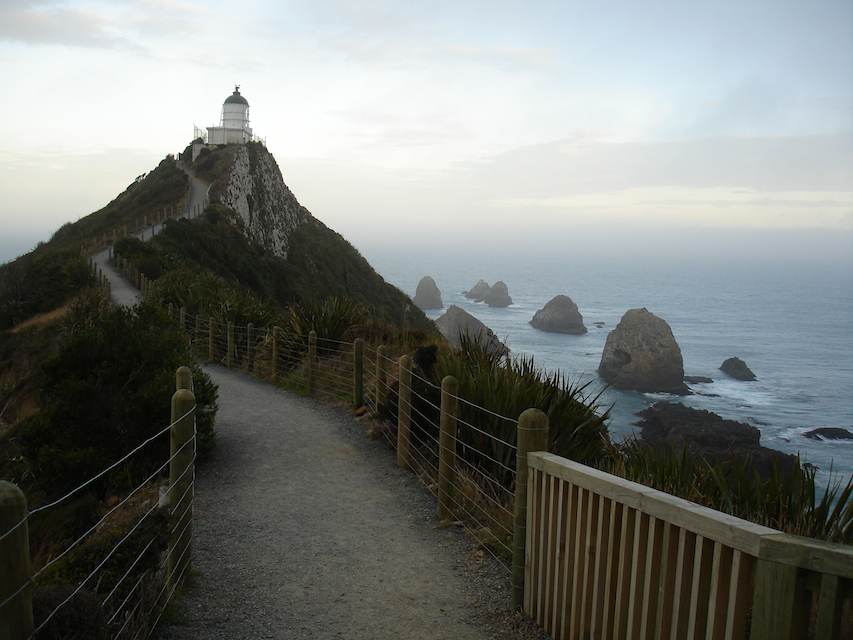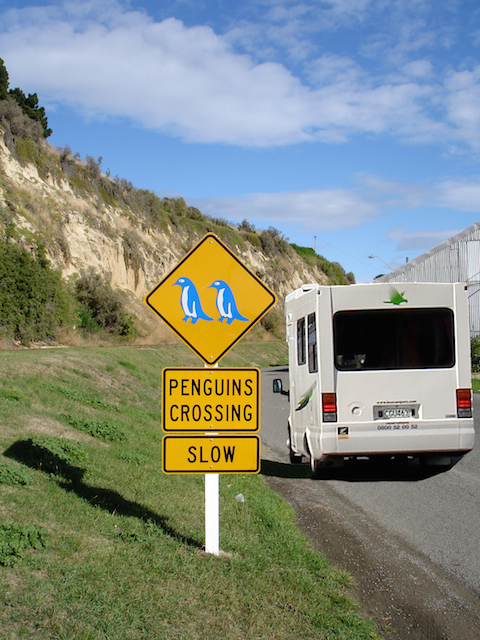“OOOH BOY!” Sandy shrieks as we round another hairpin turn on Crown Range Road, the highest sealed road in New Zealand. Her uncontrollable blurt has a distinctly different tone than her response to my question six months ago: “how would you like to celebrate our 30th in New Zealand?”
This picturesque shortcut between Wanaka and Queenstown saves 35 kilometres. As a bonus, its narrow pavement and precipitous drop-offs provide thrill seekers with a free alternative to bungy jumping. After winding our way gingerly to the valley floor, we park our motorhome at the first opportunity. Sandy leaps out, kisses the ground, then me – in that order! We continue the short distance to Arrowtown, a beautifully restored gold-mining town. Decompression requires “long black” coffees and an historic walk amidst charming old buildings. A sunshiny autumn day (March in New Zealand) marks the halfway point of our two-week camping tour of the South Island.
Five years ago, we had celebrated our 25th with a B&B tour of the North Island, a holiday that exceeded our expectations. The South Island and British Columbia have many similarities: majestic mountains, rivers and lakes, and an extensive coastline. We camp frequently back home and wanted to experience the great outdoors “down under.”
RECOVERY FROM JET LAG
Getting from Vancouver to Christchurch on the South Island takes the better part of two days. Anticipating travel fatigue, we stay two nights at the Classic Villa, a tastefully refurbished historic home in central Christchurch. After a late check-in, we enjoy all the comforts provided, especially the bed.
Following a sumptuous breakfast, we board a 1905 vintage tram that loops though the city centre. Our driver comments on places of interest including a grand Anglican cathedral, picturesque Avon River with romantic punt rides, and the Arts Centre with numerous shops, art galleries, theatres, restaurants and cafés housed within 19th century Gothic architecture. We spend the day exploring this vibrant oh-so-English city, the largest on the South Island.
A popular day trip from Christchurch is Akaroa on the nearby Banks Peninsula. Driving along the rim of an extinct volcano in our rental car provides stunning vistas, steep rugged hills speckled with sheep and beyond, the Akaroa Harbour that served as a port for early French whalers. We visit Paua Bay Farm where Murray, a fifth-generation sheep farmer, gives an impressive demonstration of his dog silently herding sheep from a hillside to a holding pen. After discussing the vagaries of sheep farming, he invites us to try our hand at shearing. Normally, sheep are sheared once a year usually in the spring before the onset of warm weather. A professional shearer can shear a sheep in two minutes, removing the fleece in one piece. We’ll likely need two hours, shearing a small clump with each tentative swipe. After a spot of tea and baked scones on the homestead verandah, we return to our Villa much the wiser about the millions of sheep we would see along the way.
LET’S GO CAMPING
We decide to rent a full-size RV rather than a campervan for more space, and also so we don’t have to make up our bed each night. Kea Campers has an outlet in Christchurch and an exceptional reputation, having won numerous awards for quality service and customer care. Bianca meets us at the airport after we return our rental car and shuttles us to their nearby facility. A brief orientation, some paperwork, and a friendly wave goodbye and we’re on our way, armed with maps, brochures and a discount card for a national supermarket. The left-handed gearshift takes some extra concentration in the ’round abouts,” but most local drivers are very considerate, especially of tourists driving rental RVs! In fact, all the Kiwis we met during our tour were considerate, helpful and friendly … “no worries.”
Our first stop, after provisioning, is Christchurch Top 10 Campground. Each of our intended destinations has a Top 10 Campground so we pre-book to ensure a power site in the event of late arrival. We are continually impressed by the high quality of each facility, far exceeding campground services back home. Each has a communal kitchen, barbecue, laundry, Internet, TV, recycling, vehicle-wash stall and information centre. Some even have food-scrap recycling (worm bins), a swimming pool, spa, golf course (9 holes, 156 metres!), bocce-ball court, trampoline, and children’s playground. Many are within walking distance of local attractions.
One noticeable difference between New Zealand and Canadian campgrounds is the absence of campfires, which we applaud as environmentally friendly — fires are totally unnecessary. Storytelling occurs in the communal kitchen, barbeque area, or around the picnic table rather than around a campfire. During our two weeks, we meet many campers from various countries, including Canada, who are renting motorhomes or campervans … all on holidays, all willing to share their travel experiences with fellow campers.
Our itinerary has us heading north from Christchurch, crossing to the West Coast, down to the South Coast, and returning back up the East Coast. Most tourists do a similar loop when traveling the South Island. Kiwis affectionately refer to us as “Loopies.” Time does not allow visiting the northern Marlborourgh and Nelson Regions, best known for their wineries and tramping tracks.
New Zealand is a relatively small country, about one-third the size of British Columbia. The South Island is long and narrow. One is never more than 80 kilometers from salt water – the Pacific Ocean on the east, Tasman Sea on the west. During our two weeks, we stay at 12 campgrounds and travel 2700 kilometres, averaging about three hours driving each day. Many commercial tourist activities are along this route, but we are most enamoured with the great outdoors – the natural splendor of the mountains and coastlines as well as the unique plants and animals native to this beautiful country.
KAIKOURA, WATCHING WHALES AND EATING CRAYFISH
A short jaunt north of Christchurch is Kaikoura, an eco-tourism destination best known for its whale-watching tours. Robert Fyfe, the town’s earliest European settler, established the first whaling station in 1845 near where his house still stands today. Within five years, whale numbers declined to the point where their exploitation became uneconomical. Today, all marine mammals are protected in New Zealand; thankfully; the whales are making a comeback. A brief documentary at the Visitor Centre provides information on the various whales that visit this coastline. For example, we learn that sperm whales, year-round visitors, can hold their breath for two hours and dive to depths of three kilometers. Blue whales, the largest creatures on the planet, have testicles weighing one ton. The commentator then says something about Humpbacks, but we didn’t catch it!
Kaikoura is a Maori (the earliest inhabitants of N.Z.) name meaning “meal of crayfish” and many eating establishments feature this popular dish. The high cost of crayfish in a restaurant or café prompts many to order from small inexpensive outlets called “takeaways.” Incidentally, taxes are included in the price of food and tipping is not expected — most Kiwis’ don’t.
Instead of whale watching, we opt for a seal and bird-watching walk along the shoreline and cliff top at the edge of the Kaikoura Peninsula. Our binoculars come in handy as most animals are on distant outcroppings. Some Dusky Dolphins frolic just offshore while a boat load of wet-suited tourists search for seals – just one of many tours offering nature encounters.
HANMER SPRINGS, A HOT SPOT
A short drive west brings us to the alpine village of Hanmer Springs where we visit the ever-popular Thermal Pools and Spa. About 90% of tourists who visit Hanmer include a visit to the pools. With nine thermal pools, three sulphur pools, a freshwater heated pool, and a large activity pool with two waterslides, we can’t decide which to try first. An observant staff suggests we start with the cooler one (33° C) and work our way to the warmest (42° C). Fortunately, we had eaten an early dinner before our relaxing soak. Back at the campground, our energy reserves are just enough to savour some Kaikoura Chardonnay and nibble cheddar curds from a local cheese factory before lights out.
THE WEST COAST, WOW
As we drive west, the view changes dramatically from relatively flat farmlands to rolling foothills and the majestic mountain ranges of the Southern Alps, backbone of the South Island. Winding our way along Buller Gorge, cabbage trees, silver beech and flax allow fleeting glimpses of the river on our right; on our left, mosses and ferns transform the rocky cliffside into a verdant carpet. At Hawks Crag the road narrows to one lane with low overhanging rock. I scrunch down in the seat, wondering whether we can squeeze through with our big rig — we later find out that tour buses use the same route! Near Westport we visit Seal Colony and watch in fascination as moms nurse their pups while juveniles play chase on the rocks below. Surprisingly, they are incredibly good climbers, negotiating rock faces with ease.
Lonely Planet rated Route 6 south of Westport as “one of the top 10 coastal drives in the world.” This 200-kilometre highway has more “wows” than a Canuk’s hockey game. Around every bend, over every rise is another breathtaking sight of craggy rocks or sandy beaches being pounded by the relentless waves of the Roaring Forties.
Pancake Rocks at Punakaiki is one of New Zealand’s visitor icons. These sculpted limestone formations, resembling stacks of pancakes, were formed 30 million years ago. Fittingly, the specialty of a nearby café is … pancakes. At Hokitika, we scan countless pebbles on the beach for the perfect stone. Sandy finds a green heart-shaped one that she uses as a “worry stone” for the remainder of our tour. She rubs while I negotiate the round-abouts, one-way bridges, and narrow back-country roads. It becomes quite shiny on our “shortcut” to Queenstown! The Franz Josef Glacier, uniquely close to the sea, is another popular tourist attraction. After camping within sight of this incredible icefall, we walk to the visitor-viewing area; then to a quiet pool for reflective views and more than a few photos.
To the south is the tiny hamlet of Haast, where the river meets the sea. Jet boating on NZ rivers is very popular; in fact the jet boat is a Kiwi invention. We had signed up for a one-hour group tour provided by Haast River Safaris. Dave, our driver/guide, demonstrates how the jet boat even with 20 people aboard skims over rocks inches below the surface and spins circles to everyone’s delight. This informative and stimulating ride into the heart of a World Heritage Site amidst waterfalls, rain forests, and snow-capped mountains is a remarkable experience.
WANAKA AND QUEENSTOWN, TRICKS AND THRILLS
The vegetation changes dramatically from lush green rain forest to alpine shrub as we proceed over the Alps to Wanaka, our next destination. We ask our campground host what we “must do” before leaving town. Peter’s immediate response: “visit Puzzling World.” This unique attraction is filled with puzzles and illusions, challenging our senses as to what is real. Buildings lean at crazy angles, holograms present realistic 3-D images, faces in a circular room follow our every movement, and distorted rooms belie our size and spatial orientation. An outdoor maze of passageways keeps us entertained (read “lost”) for nearly an hour.
After replenishing our baked goods at Ardmore Street Food Company, we take the infamous “shortcut” to Queenstown. This adventure capital of NZ, home of bungy jumping, is a Mecca for thrill-seekers. Being of that ilk, I sign up for AJ Hackett’s 47-metre Sky Swing at the Skyline Complex, high above Queenstown. Suspended from a tower, I yank a release cord and free-fall for a second or two before swinging briskly in a 400-metre arc towards the city below. This unique ride is more exciting than your average back-yard swing but, in my opinion, less exciting than bungy jumping. We then take a couple of stimulating luge rides accessed by a chairlift behind the Complex. Finally, sanity returns and we visit the lounge to enjoy a couple of “Mac’s” beers and the awesome panoramic views below. From our bar stools, we observe energetic activities such as paragliding, jet boating, America Cup boat rides, parasailing behind a boat, and bungy jumping, as well as a few sedate ones such as golfing, tour boating, and fishing.
FIORDLAND, SIGHTS OF THE SOUND
Fiordland National Park is best known for remote and magnificent Milford Sound, a special place blessed by Nature. Our campground hosts had pre-booked us on their Te Anau Top 10 Tour Bus that connects to Encounter Nature Cruise, 120 kilometres away. Although Milford is typically rainy, it’s a blue-sky day as we pull away from the dock to explore this 22 kilometre-long fiord. Pyramid-like Mitre Peak provides a centrepiece of grandeur surrounded by other peaks, overhanging granite walls, tumbling waterfalls and virgin forests. Our small cruise boat pokes its bow under Sterling Falls where we get refreshingly dunked by its powerful torrent. Along the way we’re provided with many fascinating facts about the history, geology, flora and fauna that abound in Milford Sound.
That evening, we take a half-hour boat ride across Te Anau Lake to visit the ever-fascinating glow-worm caves. Our friendly tour guide leads us through the cave explaining how rushing water over thousands of years have sculpted the unusual rock formations. As our boat glides silently through the darkness of a domed grotto, we observe thousands of tiny lights, each emitted from a small worm in search of food — truly one of nature’s wonders.
One advantage of traveling with our “home” is that we can stop wherever we like for lunch. Driving south to Invercargill, we divert onto a one-lane gravel road that leads to a cozy nook amidst boulders and tranquil bays, as close to Nirvana as one can get. The peacefulness of our picnic belies the fierce westerlies that often howl in this area, evidenced by cypress trees shredded bare on one side, slanting away from the shore.
SLOPE POINT, END OF THE ROAD
Southland Museum in Invercargill has a breeding colony of tuataras, small reptiles that once roamed the earth alongside dinosaurs. Found only in NZ, these “living fossils” are in danger of becoming extinct. The most popular specimen is Henry, more than 120 years old, who was recently provided with a potential mate, Juliet. Apparently nothing amourous appears to be developing … small wonder: he attacked his last female partners and has been celibate for over 35 years!
Another exhibit we enjoy is the artifact and real-life documentary on Burt Monroe, an ingenious, dedicated mechanic from Invercargill. In August 1967, Burt set the world speed record of nearly 300 km/h on a self-modified 1920 Indian motorcycle. He was 67. A recent movie, The World’s Fastest Indian, pays tribute to this local legend. We later drive our RV onto Oreti Beach, kilometres of smooth hard sand where Burt often tested his modified machines.
Just south at Bluff, renowned for its oysters, we hike to the observation deck on Bluff Hill for unobstructed views of the surrounding area. Across Foveaux Strait is Stewart Island, New Zealand’s third-largest. The setting sun casts a deepening pink glow on the seascape as if toasting us “Kia Ora” (good health).
While touring the North Island on a previous trip, we drove as far north as we could go — Cape Reinga. Here on the South Island, traveling towards Dunedin, a side road leads to Slope Point, as far south as we could go. Sandy crawls to the cliff edge and extends her hand over, challenging me to see who can get further south. Given my fear of dying, I take a photo of the winner from a respectable distance back! We continue on the scenic coastal route through a region known as the Catlins. Natural attractions include 180 million-year-old fossilized trees, picturesque waterfalls, imposing sea-sculpted caves, expansive beaches and at Nugget Point, rocky sentinels and panoramic views over the Southern Ocean.
PENGUINS, THE CUTEST BIRDS
Dunedin, the South Island’s second largest city, is the commercial centre of the Otago Region. Home of New Zealand’s first university, it exudes youthful energy most evident in the bustling pubs and sidewalk cafés around its octagonal city-centre. Following the advice of our campground host, Margaret, we spend the day on the Otago Peninsula. Our first stop is the neo-Gothic Larnach Castle for a self-guided tour of the only castle in NZ. We then continue to the end of the peninsula to view the only mainland albatross-breeding colony in the world. Unfortunately, foggy conditions prevent us from observing the birds directly. Instead, we peruse the Taiaroa Head Visitor Centre’s excellent display about these and other sea birds. On our return, we stop at Portobello’s Marine Studies Centre, an educational and research facility for a close up look and feel of many species of indigenous plants and animals in their aquarium.
The next day, we spend a couple of hours wandering through Dunedin Botanic Garden. Thousands of plants from NZ and other countries are organized in a variety of collections. Their aviary houses some 400 birds, including both native and exotic species. We make a note to come back for days on our next visit.
Baldwin Street, which lays claim in the Guinness Book of Records as “the steepest street in the world,” is in a quiet residential neighbourhood in Dunedin. On its steepest section, the pavement rises one metre for each 2.86 metres traveled horizontally, too steep for our RV.
Further up the East Coast, we stop at Moeraki to view spherical boulders that resemble huge turtles on the beach. These unusual formations were slowly built up over four million years ago.
Near the Moeraki lighthouse, a stepped trail leads down the cliff to a “hide” where we watch sea lions sunning on the rocks. Suddenly, a yellow-eyed penguin emerges from the surf and waddles across the beach to its roost in a hillside of flax. Then another, followed by others one or two at a time. What a delight to see these cute birds, dipsy-doodling between the imposing sea lions.
Later, in Oamaru we watch a colony of little blue penguins return from a day of fishing to their cliff-side homes. A commentator provides insights into the history of the colony, breeding and molting cycles, and who is courting whom. Within the next hour, about 50 birds in small clusters waddle up the beach and tentatively cross the road in front of a specially-built grandstand. Spectators are advised to keep still so as not to disturb this natural ritual. Leaving the parking lot, we spot one wayward bird in a clump of flax by the roadside, justifying the many signs for motorists: Slow, Penguins Crossing.
END OF THE LOOP, UP AND AWAY
A visit to the South Island is not complete without a visit to Mt. Cook — at 3755 metres, the highest peak in NZ. We drive inland through the Waitaki Valley, which reminds us of rolling farm country in Ontario, to a viewing area on the south shore of Lake Pukaki. Today, clouds obscure the peak so we lunch leisurely enjoying the stunning scenery, rather than drive the lengthy road to the mountain village. Further east, we visit the beautiful Church of the Good Shepherd on the shore of Lake Tekapo, a memorial dedicated to the early settlers of this region. With a new appreciation of the endurance, strength and reverence of these pioneers, we feel a tinge of guilt as we drive off in our deluxe RV to our campground in Fairlie.
Our last scenic drive through Mackenzie country ends in Christchurch where we deposit the RV and return to the airport. As we lift off the runway and gain altitude, we peer out the window at a familiar and magnificent landscape, stretching from sea to sea. Our camping tour was indeed a celebration, providing enough memories to last another 30 years.
IF YOU GO:
Use your Bank Card to withdraw $NZD from ATMs as required.
Take binoculars, a plug-in converter, camera and battery charger.
Don’t pack any liquids in carry-on luggage; even Manuka honey is confiscated by Security.
Allow at least three weeks on each island, more if you can.
Use a guidebook, such as Lonely Planet, to plan and adjust your itinerary.
Take sturdy hiking shoes and a sense of adventure.
Practice saying “WOW” with enthusiasm.
FOR INFO:
Travel website for New Zealand: www.newzealand.com/ca/
The Classic Villa: www.theclassicvilla.co.nz
Kea Campers: www.keacampers.com
Top 10 Campgrounds: www.top10.co.nz
Hanmer Springs Thermal Pools and Spa: www.hanmersprings.co.nz
Haast River Safari: www.haastriver.co.nz
Puzzling World: www.puzzlingworld.co.nz
AJ Hackett Sky Swing: www.ajhackett.co.nz
Queenstown Gondola Station: www.skyline.co.nz
Milford Sound Encounter Nature Cruise: www.redboats.co.nz
Te Anau Glowworm Caves: www.realjourneys.co.nz
Southland Museum: www.southlandmuseum.com
Larnach Castle: www.larnachcastle.co.nz
Royal Albatross Colony: www.albatross.org.nz
Portobello Marine Studies Centre: www.otago.ac.nz/marinestudies
Dunedin Botanic Garden: www.dunedinbotanicgarden.co.nz
Oamaru Blue Penguin Colony: www.penguins.co.nz
